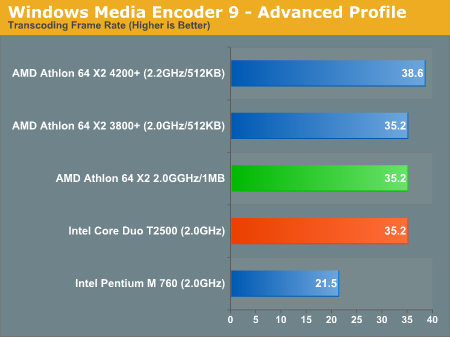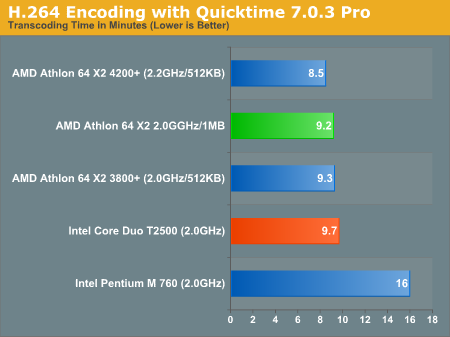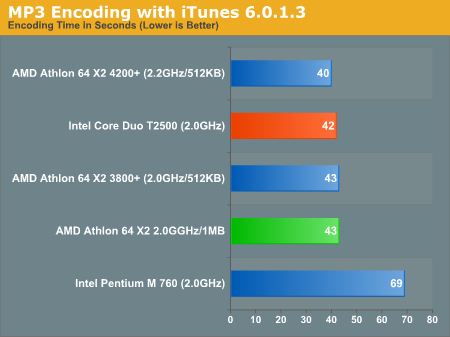Intel Core Duo (Yonah) Performance Preview - Part II
by Anand Lal Shimpi on December 19, 2005 12:55 PM EST- Posted in
- CPUs
Media Encoding Performance with DVD Shrink, WME, Quicktime and iTunes
We were most curious about the Core Duo's media encoding performance, given that a number of the optimizations for the new processor were FP/SSE related. We've updated our entire media encoding test suite, including everything from the one-click DVD ripping utility DVD Shrink to including H.264 encoding performance with Quicktime 7.0.3 Pro. We wanted to include the latest version of DivX in this comparison. However, the recent release of DivX 6.1 left us with a few bugs that we're still trying to work out in our test beds, so we had to exclude it. However, as time goes on, H.264 encoding will quickly become far more important than even looking at DivX, so its omission from this article isn't as big of a loss in terms of forward-looking performance.
First up is DVD Shrink 3.2.0.15. Our test was simple - we took a copy of Star Wars Episode VI and ripped the full DVD to the hard drive without compression, effectively giving us an exact copy of the disc on the hard drive. Then, using the copy of the DVD on the hard drive (to eliminate any DVD drive bottlenecks), we performed a DVD shrink operation to shrink the movie to fit on a single 4.5GB DVD disc. All of the options were left on their defaults, so the test ends up being pretty easy to run and reproduce. The scores reported are DVD encoding times in minutes, with lower numbers meaning better performance.
The DVD Shrink test is quite important as DVD Shrink is quite possibly one of the easiest tools to rip a DVD. The easier a tool is to use, the more likely it's going to be used, and arguably the more important performance using it happens to be.
Moving on, we have our Windows Media Encoder 9 test, which uses the advanced profile settings for video encoding. We left all settings at their defaults and just proceeded with a MPEG-2 to WMV-HD conversion. The values reported are in frames per second, with higher numbers being better.
Next up, we have Quicktime Pro 7.0.3 and we perform a MPEG-2 to H.264 encoding task. All of the settings are left at their defaults, with the exception that we optimize the output file for download with a 256kbps data rate while leaving the resolution untouched. We also adjust the video options to optimize for the best quality. We report the transcoding time in minutes, with lower values being better.
Finally, we have a MP3 encoding test using iTunes 6.0.1.3. For this test, we simply took a 304MB wav file and converted it to a 192kbps MP3 file, measuring the encode time in seconds. The only iTunes option that we changed was to prevent the playback of the song while encoding.
We were most curious about the Core Duo's media encoding performance, given that a number of the optimizations for the new processor were FP/SSE related. We've updated our entire media encoding test suite, including everything from the one-click DVD ripping utility DVD Shrink to including H.264 encoding performance with Quicktime 7.0.3 Pro. We wanted to include the latest version of DivX in this comparison. However, the recent release of DivX 6.1 left us with a few bugs that we're still trying to work out in our test beds, so we had to exclude it. However, as time goes on, H.264 encoding will quickly become far more important than even looking at DivX, so its omission from this article isn't as big of a loss in terms of forward-looking performance.
First up is DVD Shrink 3.2.0.15. Our test was simple - we took a copy of Star Wars Episode VI and ripped the full DVD to the hard drive without compression, effectively giving us an exact copy of the disc on the hard drive. Then, using the copy of the DVD on the hard drive (to eliminate any DVD drive bottlenecks), we performed a DVD shrink operation to shrink the movie to fit on a single 4.5GB DVD disc. All of the options were left on their defaults, so the test ends up being pretty easy to run and reproduce. The scores reported are DVD encoding times in minutes, with lower numbers meaning better performance.
The DVD Shrink test is quite important as DVD Shrink is quite possibly one of the easiest tools to rip a DVD. The easier a tool is to use, the more likely it's going to be used, and arguably the more important performance using it happens to be.

- The Pentium M performs exceptionally poorly, and
- The Core Duo performs exceptionally well.
Moving on, we have our Windows Media Encoder 9 test, which uses the advanced profile settings for video encoding. We left all settings at their defaults and just proceeded with a MPEG-2 to WMV-HD conversion. The values reported are in frames per second, with higher numbers being better.

Next up, we have Quicktime Pro 7.0.3 and we perform a MPEG-2 to H.264 encoding task. All of the settings are left at their defaults, with the exception that we optimize the output file for download with a 256kbps data rate while leaving the resolution untouched. We also adjust the video options to optimize for the best quality. We report the transcoding time in minutes, with lower values being better.

Finally, we have a MP3 encoding test using iTunes 6.0.1.3. For this test, we simply took a 304MB wav file and converted it to a 192kbps MP3 file, measuring the encode time in seconds. The only iTunes option that we changed was to prevent the playback of the song while encoding.

Professional Application Performance with 3dsmax, Adobe Premier and Photoshop
Gaming Performance with Battlefield 2 and Black & White 2










103 Comments
View All Comments
fitten - Tuesday, December 20, 2005 - link
Which should make you think about the supposed "magic" of the on-die memory controller that everyone constantly raves about as being *the* reason why the Athlon64 is as good as it is (hint: there are other reasons, the IMC is just one piece of why).
Marmion - Monday, December 19, 2005 - link
I don't get it why everyone expects a mobile chip to out-perform a desktop chip.Yonah/Core Duo is specifically a low power optimised dual core processor for laptops. Its fine to use it as an indication of the future conroe/merom, but bear in mind that these will see faster clocks, further optimisations for their specific use (desktop/mobile respectively).
Next month, Intel will have no competition for dual core laptops untill the Turion X2 comes out. Will you think that the mobile version of a desktop processor will be able to perform the same? No, because of optimisations for the all-important mobility factor (battery-life and weight).
If you want an uber-powerful desktop replacement X2 processor-powered laptop, you can do that now. But expect no battery life and an aching back or a soar arm from carrying around a 4kg+ brick. So, Intel is now offering a laptop processor, capable of performing similarly to a desktop processor, but with low power consumption, long battery life and low weight.
What am I trying to say? A Turion X2 may be slower than current Athlon X2s and yes I know 65nm vs 90nm. It probably won't be faster anyway, so Intel have a fast, efficient and cheap processor - hey you expect Turion X2 to be as cheap as the single core version?
Apples to oranges? Get over it! The Core Duo uses DDR2, AMD X2 DDR. Intel FSB, AMD Mem controller. You will never get an apples to apples comparison - its business, competition, differentiated products, call it what you like, you buy AMD, you use different RAM, different Mobos, different drivers to Intel, end of story, so its a comparison of platforms, not CPU.
*end rant*
fitten - Tuesday, December 20, 2005 - link
They don't... and that's the point and why many are impressed with Yonah... that it *does* perform favorably to a desktop platform.
Leper Messiah - Monday, December 19, 2005 - link
how do you know its going to be cheap? As far as I have seen, there are no prices released for these processors yet. And do you wanna know why we're somewhat dissapointed? Intel (and its fanbois) have been talking about how this new arc. is supposed to be the next big thing. In its current form, its not really.stateofbeasley - Monday, December 19, 2005 - link
http://www.theinquirer.net/?article=26062">http://www.theinquirer.net/?article=26062Price points are the same as the current platform.
Yonah is not NGMA. Yonah is a P6 family processor.
People must read the news before they post!!!!
coldpower27 - Monday, December 19, 2005 - link
This isn't really new architecture, the next big thing is supposed to be Intel's NGMA, where alot of changes are going to be made.KayKay - Monday, December 19, 2005 - link
I am an AMD fanboybut the results (power consumption esp.) are very impressive
guess intel wants to keep things competitive
hope amd ups the ante in response
eetnoyer - Monday, December 19, 2005 - link
With AMD announcing the use of SiGe in processors coming up very soon, it looks like they could still get a decent drop in power consumption at 90nm. I'd guess that's what they're waiting for to release the Turion x2. I doubt that it will be quite enough to match the power consumption of Yonah, but should mostly suffice until the 65nm shrink. It will also apparently serve to greatly reduce the area required for L2 cache by shrinking the cells. Once that happens I imagine that AMD will hold a small power/performance lead over Merom/Conroe/Woodcrest since adding 64 bit will tend to up their power consumption somewhat. At that point, AMD will be using SOI and SiGe, while Intel will only be using SiGe.As for continuing the ramp of frequencies, I don't think that it's going to play a hugely significant role going forward. That's why everyone is going multi-core these days. It looks like rough performance parity is here to stay between the two. What I think AMD is aiming at is a duopoly in the CPU market. That is the point of the lawsuit, and the greatly expanding capacity that AMD is targeting (Fab36, Chartered, Fab38, etc...). What Intel really needs to worry about is AMD's ability to increase their brand awareness and supply large vendors reliably. Once that happens, Intel will need to compete on price. While AMD is very comfortable living on $100 ASP, that would be catastrophic to Intel's bottom line. I think over the next few years (barring any catastrophic screw-ups by AMD) we are going to see alot of cost-cutting at Intel.
Sorry for the off-topic ramblings, but I tend to look at things from an investors' POV.
Leper Messiah - Monday, December 19, 2005 - link
So I guess the biggest question for these (at least to me, since I don't have a need for an uber-lappy) is price and a converter for a mobo, and I guess OC-abilty. If they can match clock speeds of the x2s (2.6GHz+) and come out to be cheaper, then I might consider buying one of these, but I don't see AMD's desktop market being threatened, considering Intel's last gasps with netburst (let it die already!).If AMD can milk another 400MHz or so out of its K8 arctechture in its current form, they'll stay competitive with mermom it seems to me. Yonah certainly isn't the AMD killer the intel fanboi's have been heralding it as though.
fitten - Tuesday, December 20, 2005 - link
I've seen a number of "reports" of these Yonahs (Core Duo) hitting 2.5GHz quite easily without even raising the voltage. It's "as if" it were designed to run in the 2.5-2.6GHz range but not released that way... yet.